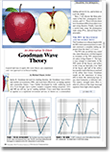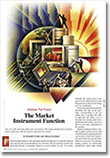Letters To The Editor
February 2011 Letters To The Editor
The editors of S&C invite readers to submit their opinions and information on subjects relating to technical analysis and this magazine. This column is our means of communication with our readers. Is there something you would like to know more (or less) about? Tell us about it. Without a source of new ideas and subjects coming from our readers, this magazine would not exist.
Address your correspondence to: Editor, Stocks & Commodities, 4757 California Ave. SW, Seattle, WA 98116-4499, or E-mail to editor@traders.com. All letters become the property of Technical Analysis, Inc. Letter-writers must include their full name and address for verification. Letters may be edited for length or clarity. The opinions expressed in this column do not necessarily represent those of the magazine. —Editor
GOODMAN WAVE THEORY
 Editor,
Editor,
I read Duane Archer’s article in the December 2010 issue of Stocks & Commodities (“Goodman Wave Theory”) and couldn’t help but notice the similarities between the Goodman wave (Gwt) and AB=CD or Abc pattern. What are the significant differences between them and the advantages of one over the other? I recognize that the Gwt has a number of additional rules whereas the AB=CD pattern boils down to about three or four. I guess I’m wondering why I would go for a more complicated system unless it offers significant trading advantages over one I already use. Could you ask the author for his thoughts?
—L.A. Little
Duane Archer replies:
Gwt is both a refinement and expansion of the old 50% measured move [AB=CD] rule.
The propagation principle is an expansion allowing the creation of several templates for forecasting. The intersection and 3-C rules are refinements for delimiting possibilities and zeroing in on legitimate trade candidates.
These are the three primary principles of Goodman wave theory, but there are quite a few more principles and rules. My article in the December 2010 issue was simply meant as an introduction.
ERRATA: DECEMBER 2010 TRADERS’ TIPS (MICROSOFT EXCEL)
Editor,
I was recently contacted by a reader who had been playing with the settings on the “TradingIndexesWithHullMA” spreadsheet that I contributed to the December 2010 Traders’ Tips column. The reader noticed there were buy and sell plot anomalies when he used settings that caused more frequent trades.
I have found and fixed a problem in the formula controlling the active position (column AE). This necessitated changes to rebalance formulas in other columns in the “One Symbol Trading Model” area of the spreadsheet.
—Ron McAllister
rpmac_xltt@sprynet.com
The revised spreadsheet can be downloaded from the December 2010 Traders’ Tips area at Traders.com.
—Editor
MARKET INSTRUMENT FUNCTION
 Editor,
Editor,
Great article (“The Market Instrument Function” by Alexander Ershov and Aleksey Gerasimov, December 2010 S&C) — just not for S&C. Maybe the article would be more in line with a mathematical journal. The article lacks too many things to be of actual use for a trader. If a problem had been a worked out, the information could have been useful and validated. For example, if the data and process were given for the any of the forecast charts (Dia, or Spy) the charts could be replicated and the conclusions could be verified. As it stands, the methodology proposed in the article must be taken on faith.
If the article was a promotion piece for a company, that company was not listed, nor was the contact information given for the authors. Are any of these missing pieces (authors’ contact information, company, methodology, and completed solution for the charts) available?
—James A. Olson
Gray, TN
Editor,
The article “The Market Instrument Function” published in the December 2010 S&C left me very enthusiastic about using this signal-processing technique but also perplexed as to how to do just that. After reviewing the “Mathematical Discussion” sidebar, I have some questions for the authors:
- What is the meaning of variable l_h(t)? This variable is not defined anywhere.
- How does one compute the value of operator A given stock price data?
- Is the value of delta_n the stock price at time tau?
—Eric Lanoix
Editor,
I found the December 2010 S&C article “The Market Instrument Function” difficult to understand mathematically and conceptually. In my many years reading financial magazines I have never come across anyone who is willing to project market pricing (S&P 500 and Dia) three to four years into the future as these two authors seem willing to do.
In the article’s sidebar titled “Mathematical Discussion,” the authors seem to state that the price series would follow a random-like Gaussian response. If the price series is in fact random, isn’t it by definition unpredictable? In my own studies of the S&P 500 and Dia, I have found both of these market indexes to be near-random in their price series when measured over a few years’ time.
—Norm Brown
Author Alexander Ershov replies:
The mathematical part of our article is complicated and will be understandable only to a narrow circle of mathematicians, namely specialists in the field of solving Fredholm integral equations of the first type, who study such questions for more than a year or two. The complete mathematical texts will be incomprehensible for most of readers.
We could write a few more articles that focus on the mathematical theories of our work that may make it clearer.
JM INTERNAL BAND
Editor,
I very much enjoyed Koos van der Merwe’s article in the December 2010 issue of Stocks & Commodities (“Less Stress With The JM Internal Band”) and would like to obtain the MetaStock formula for the JM internal band. Could he provide it, or tell me where I can obtain it? It’s not on the MetaStock website as of this moment.
—Bob Robertson
Koos van der Merwe replies:
Here is the MetaStock formula you requested:
Bnd:= Mov(C ,15 ,S ) ; UpBd:=1.02*Bnd; LwBd:=0.98*Bnd; UpBd; LwBd
Editor,
I am a little confused on how author Koos van der Merwe defines +2% or -2% in his December 20010 article, “Less Stress With The JM Internal Band.”
Shouldn’t these lines be parallel to the 15-period simple moving average (Sma)? In the article, it says, “offset it upward by 2% and downward by -2%.” To me, that would mean a band of 2% over the Sma. But the lines on his charts do not look parallel. What am I missing? I appreciate any clarification he can offer.
—Satish Sharda
Koos van der Merwe replies:
You are not wrong. By all accounts, they would be parallel lines if drawn horizontally, but here, you have a moving average on a moving closing price, and as you well know, if you take that moving average and multiply it by 102% and again by 98% to get your 2% offset, it will no longer be parallel. When the price falls rapidly, the band will narrow and vice versa.
I have looked at these bands on charts using Advanced Get, MetaStock, TechniFilter Plus, and OmniTrader, all programs I use to evaluate the stock market, and all the bands widen and narrow in exactly the same way. I use the following formula, which is shown here in MetaStock format:
Bnd:= Mov(C ,15 ,S ) ; UpBd:=1.02*Bnd; LwBd:=0.98*Bnd; UpBd; LwBd
Perhaps the fact that the band widens and narrows is the secret of its success.
I must admit that on occasion, the 2% offset is too much, and then I will reduce the offset to 1% and very occasionally to even 0.5%, but that is rare. It is something you can play with to find what best suits your risk.
I hope you enjoy using the strategy. I have.
MORE ON JM INTERNAL BAND
 Editor,
Editor,
I enjoyed reading Koos van der Merwe’s article in December 2010 S&C, “Less Stress With The JM Internal Band.”
I wrote the code shown below in AmiBroker and ran some backtests, but I was not able to replicate van der Merwe’s results. Could the author let me know what might be missing? All backtesting execution was done at the opening price of the next bar. Since we won’t know the closing price during a trading day, I used the open to calculate the moving average. But I still used the close to determine the buy/short signal for the next day’s open.
As for the stop, I used the “open” moving average cross, since after the open we’ll know whether the stop will be hit. We won’t know whether any other price will be hit during the rest of the day except for the open. Thus, the buy/sell happens at the open of the next day, and sell/cover happens at the open of the current day.
AmiBroker code: bnd = MA(Open, 15); upbd = bnd * 1.02; Lwbd = bnd * 0.98; Buy = Close > upbd AND Ref(Close, -1) < Ref(upbd, -1); Short = Close < Lwbd AND Ref(Close, -1) > Ref(Lwbd, -1); Sell = Cross(bnd, Open); Cover = Cross(Open, bnd); SellPrice �= Open; CoverPrice = Open;
Attached are example equity curves of Aapl and Qld [not shown — Editor]. Please let me know if I’m missing something or how I may reproduce the findings.
—David
Koos van der Merwe replies:
I can only say that over the years, I have done very well using the JM internal band strategy. I’m not sure whether your equity curves are good or not, although they do look as if they are. Your formulas suggest an improvement on the strategy. I will have to test them and see what happens. Thank you for writing.
Editor,
I thought Koos van der Merwe’s article in the December 2010 issue was wonderful (“Less Stress With The JM Internal Band”). I am planning to read his past articles published in S&C. How can I obtain them?
Mainly, I would like to know more about his approach to buying and selling stocks. —Sami
Editor: You can access past S&C articles by Koos van der Merwe via this magazine’s website at Traders.com. Search for the author name using the search function. Past S&C articles can be purchased through the Online Store at our website. Articles by van der Merwe in our online publication, Traders.com Advantage, can be obtained by becoming a subscriber to that publication at our website.
Koos van der Merwe replies:
My approach to buying and selling stocks? It depends on whether you are taking a long-term view or a short-term view. In all my years in the investing profession (about 40-plus years), I have found that people with busy, full-time jobs often cannot do well at short-term trading because they just don’t have the time to spend on studying the market.
I have written before in this magazine about some of the technical analysis programs I like to use to analyze the market. For my short-term trading, with commissions being less than $10, I use a program that gives me daily buy/sell signals. The biggest challenge I personally have is trying to implement the buy/sells like a robot, doing what the program tells me to do and not allowing my emotions to rule.
In general, you have to decide whether you want to do long-term or short-term trading, and how much time you can spend analyzing and studying the markets. Knowing that makes it easier to select an appropriate technical analysis program. With that information, I could provide more specific suggestions on programs for you to take a look at.
Editor,
Thanks for Koos van der Merwe’s article in the December 2010 S&C (“Less Stress With The JM Internal Band”); I really enjoyed it.
I am looking to get my Cmt (Chartered Market Technician designation), but I have not had any luck finding work as an analyst. Would the Cmt level 1 help? I have been doing this as a hobby and a passion for 10 years. I have done well trading in my 401k; my daytrading has gone okay although I could use more discipline. Does van der Merwe have any advice? I am sure it’s not easy to find work these days, so I would appreciate any advice he may have.
—Jonathan
Koos van der Merwe replies:
Obtaining a qualification like the Cmt or similar is always of value, because it’s always an educational experience. Will it help you find work with company like Goldman Sachs or the like? That I cannot answer. In today’s world, most brokerage houses look for salespeople who will collect assets for the company. Where those assets are invested is usually a decision made by analysts in that company, and most of them have been in the business a long time, with their own techniques and ideas. You have to just keep looking and submitting resumes.
As to discipline, I have two mottoes. Both are posted on my computer in front of me. The first came from Samuel Goldwyn of Metro-Goldwyn-Mayer fame: “It’s always difficult to forecast, especially the future.” The second has been with us for a much longer time: “A bird in the hand is worth two in the bush,” meaning that cash is always king, so always be disciplined in your trading.
I was always fortunate when I lived in South Africa; I was headhunted because I had joined analyst societies and groups and made myself known as a research analyst by giving talks on technical analysis. In Canada, where I now live, it has not been so easy. The smaller brokerage houses are mainly looking for revenue generation, and as you so rightly say, it will not be easy finding a job.
I wish you well in your efforts to establish yourself in the industry.